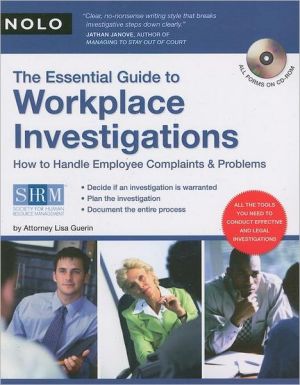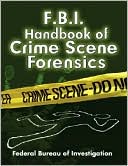The Essential Guide to Workplace Investigations: How to Handle Employee Complaints & Problems
Everything you need to investigate -- and resolve -- common workplace complaints and problems.\ \ The Essential Guide to Workplace Investigations is both a legal and practical book, packed with tips and strategies that will help you sort out your workplace problems, quickly and legally.\ \ It offers a 10 you can use to resolve all kinds of workplace complaints, including:\ \ *harassment\ *discrimination\ *workplace violence\ *employee theft\ \ The Essential Guide to Workplace Investigations...
Search in google:
Everything an HR professional, manager or business owner needs to know about resolving employee complaints and problems, legally. HR Magazine Packed with tips and strategies that will help sort out workplace problems quickly and legally.
Introduction\ Chances are good that you picked up this book because you've become aware of a potentially serious problem at your company and you're not quite sure how to handle it. Maybe you've heard a complaint or report of misconduct that sounds something like this:\ "Every time I go into John's office, he's looking at porn on the Internet -- it's really starting to offend me and some of the other women in the office."\ "We've finished our internal audit, and the numbers just don't add up. I think we may have a thief on our payroll."\ "I've been passed over for promotion three times, and each time the job has gone to a younger person who doesn't have my experience or training. I feel like I'm being discriminated against."\ "Mark has been really angry lately -- he keeps talking about his gun collection, and yesterday he told me that 'management is about to get what's coming to them.' I'm afraid of what he might do."\ Now you're facing some tough decisions: Whom should you believe? What really happened and why? How serious is this problem? What should you do about it? And, can you handle this without creating legal problems for the company?\ A complete, impartial, and timely investigation will help you answer these questions and figure out what to do. In fact, a proper investigation is one of the most important tools for maintaining a safe and productive workplace -- and keeping your company out of legal trouble.\ This book gives you the tools and information you need to conduct a successful investigation. Part I (Chapters 1 through 4) describes in detail the ten steps to a successful investigationof any kind of workplace problem. Part II (Chapters 5 through 8) takes a closer look at four common workplace problems -- discrimination, harassment, theft, and violence -- and explains how to handle the special investigation challenges posed by each.\ This chapter will help you get started. It introduces the benefits and basic components of a proper workplace investigation, including the actions you will have to take -- and decisions you will have to make -- along the way. (Each of these steps is covered in detail in Chapters 2 through 4.) It also covers some common investigation mistakes that can lead to legal trouble -- and tips that will help you avoid them.\ \ \ Investigations Require Judgment Calls\ Although most investigations will require you to at least consider each of these ten steps, every situation is a little bit different. Workplace problems rarely land on your desk in a tidy package with an obvious solution. Instead, you'll often be faced with conflicting stories, documents that are open to different interpretations, and no clear answers about what happened and what you should do about it. You'll have to decide which problems merit a closer look, whom to interview, and what documents to review -- and when your investigation is complete, you'll have to decide what you think really happened.\ All of these decisions are judgment calls, and no book can tell you how to handle every possible scenario you might face. However, if you follow the guidelines in the chapters that follow, keep an open mind, and use your best judgment, you should be able to handle most of the issues that come up.\ \ \ The Benefits of an Effective Investigation\ Although you might not be happy to learn that you have a workplace problem, investigating and resolving it in the right way can strengthen and protect your company. Among its many benefits, a proper investigation will help you:\ \ Figure out what happened. The immediate aim of any investigation is to get to the bottom of a problem. You won't know how to handle a situation until you know what really happened. And, acting before you have all the facts could lead you to discipline the wrong\ employee or allow a workplace problem to continue.\ \ \ Deal with employee problems early. An investigation will help you figure out who's behind a workplace problem, so you can take action before things get any worse. If you are dealing with a problem employee, he or she can be disciplined. If you discover that employees are breaking the rules because they don't know what's expected from them, you can implement training programs, work harder to publicize and distribute company policies, and make sure\ managers are enforcing the rules.\ \ \ Enforce company policies. If a company doesn't enforce its own policies, the company's employees quickly realize that they don't have to follow the rules. Showing employees that there are consequences for misconduct will help deter future trouble and keep employees on the right track.\ \ \ Encourage reporting. Investigating and dealing with problems quickly will encourage employees to come forward with their issues and concerns. This means that you'll hear about workplace trouble right away, before it has a chance to grow into a more serious problem.\ \ \ Avoid or counter bad publicity. A company that ignores complaints and problems gives the impression that it doesn't care about its workers or the law. And if your company's failure to deal with a problem becomes public knowledge -- through a lawsuit, for example -- it could really hurt the company's reputation.\ \ \ Protect your company from lawsuits. A solid investigation will help your company avoid or defend against legal challenges in the future. If someone who is injured by workplace misconduct -- an employee who is sexually harassed, for example -- sues your company, you can show that you took action right away, which will protect your company from liability in many cases. If an employee who was disciplined or fired as a result of your investigation files a lawsuit, you will be able to show that you acted reasonably and in good faith, which will undermine the employee's claims.\ \ \ \ By the same token, however, a slipshod investigation can lead to employee lawsuits, by giving employees the ammunition they need to demonstrate that your company was careless, discriminated, spread false information, or treated employees poorly, among other things. And\ failing to investigate at all is even worse -- if an employee can show that company management knew about a problem and didn't do anything about it, the company will be legally responsible for any harm that employee suffered.\ So how do you conduct the right kind of investigation? By being fair and thorough and making good-faith efforts to get to the truth. Even if you come to the wrong conclusion, your company should be able to show that it was legally entitled to take action (for example, to discipline or fire an employee) based on the results of your investigation, as long as you investigated properly and your decisions were reasonable based on the information available to you.\ \ \ \ Example: Ralph was accused of sexually harassing two female coworkers. The company immediately performed a complete investigation, interviewing the women, Ralph, and a number of witnesses -- including five Ralph suggested. Based on these interviews, the company concluded that Ralph had in fact harassed his coworkers and fired him.\ Ralph later sued the company, claiming that he had a consensual affair with both women, no harassment had occurred, and the women were angry with him for two-timing them. (Ralph did not tell any of this to the company's investigator.) The jury found in Ralph's favor. However, an\ appeals court decided that it didn't matter what really happened. As long as the company conducted a fair and thorough investigation and reached a good-faith conclusion based on the information available to it at the time, it was not liable for firing Ralph based on the investigation's results.\ \ \ \ \ Your Role in the Investigation\ This book addresses every aspect of workplace investigations, from start to finish. Depending on your role at your company, you may be responsible for all, most, some, or just a few of the actions and decisions described in this book. For example, you may be called upon to decide whether an investigation is necessary, but your company may then use an outside investigator to handle the legwork. Or, you may be responsible for performing the investigation, but not for deciding what discipline or other action to take based on your findings.\ No matter what aspects of the investigation fall within your job description, you'll find the information you need in this book. We've covered all of the duties associated with an investigation, to make sure that all of our readers are fully equipped to handle every part of the investigation for which they are responsible.\ \ \ Ten Steps to a Successful Investigation\ The best way to tackle an investigation -- like any other project -- is to divide it up into manageable tasks. Fortunately, most workplace investigations follow a similar pattern, although the details can vary considerably. Once you become aware of a problem or complaint, you'll have to follow these ten steps:
Part I: Investigation Basics1. Workplace Investigations: An OverviewThe Benefits of an Effective InvestigationTen Steps to a Successful InvestigationCommon Investigation Mistakes -- and How to Avoid Them2. Getting StartedDiscovering Workplace ProblemsDecide Whether to InvestigateTake Immediate Action, If NecessaryChoose the InvestigatorPlan the Investigation3. Gather InformationGet Started Right AwayConducting InterviewsGathering Other EvidenceFollow-Up Interviews4. Make and Document Your DecisionEvaluate the EvidenceDecide Whether Misconduct OccurredTake ActionDocument Your DecisionFollow UpPart II: Investigating Common Workplace Problems5. Investigating DiscriminationWhat Is Discrimination?Ten Steps to an Effective Discrimination Investigation6. Investigating HarassmentWhat Is Harassment?Ten Steps to a Successful Harassment Investigation7. Investigating Workplace TheftHow Employees StealTen Steps to a Successful Theft Investigation8. Investigating Threats and ViolenceThreats and Violence in the WorkplaceTen Steps to a Successful Investigation of ViolenceA. Appendix A: Workplace PoliciesComplaint PolicyOpen-Door PolicyAntidiscrimination PolicyAntiharassment PolicyAntiviolence PolicyB. Appendix B: Forms and ChecklistsComplaint Reporting FormInvestigation Notice FormInvestigation Report FormAdverse Action Notice FormChecklist: Ten Steps to a Successful InvestigationChecklist: Avoiding Common Investigation MistakesDocument ChecklistCredibilityChecklistDiscipline ChecklistInvestigation Report ChecklistC. Appendix C: Sample Investigation DocumentsComplaint Reporting FormInterview with Bill MartinezInterview with Louise JayInterview with Sharon WashingtonInterview with Skip ThompsonInterview with Brian HaggertyInterview with Jocelyn Evans (Follow-Up)Interview with Skip Thompson (Follow-Up)Investigation ReportWritten WarningInvestigation FileD. Appendix D: ResourcesState Laws Prohibiting Discrimination in EmploymentState Agencies That Enforce Laws Prohibiting Discrimination in EmploymentResources on HR and Employment Available From NoloResources on HR and Employment Available From SHRME. Appendix E: How to Use the CD-ROMOption 1: Accessing Investigation Resources from the CDOption 2: Installing and Accessing Investigation Resources on Your ComputerFiles Included on This CD-ROMIndex
\ HR MagazinePacked with tips and strategies that will help sort out workplace problems quickly and legally.\ \ \ \ \ From the Publisher"Packed with tips and strategies that will help sort out workplace problems quickly and legally." HR Magazine\ “Everything an employer needs to know about investigating and resolving workplace complaints and issues is packed into this book, making it a top recommendation for any business library strong in human resources guides. It's the first on the market to teach businesses how to investigate and resolve all types of complains, from harassment and discrimination to workplace violence and employee theft, and walks the manager through ten basic steps from the initial decision to investigate to interviewing, gathering and evaluating evidence, and taking action. All business libraries need this.” California Bookwatch\ \








